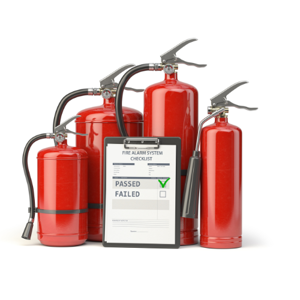
Like any other safety equipment, a home fire extinguisher should be inspected regularly to ensure it's in proper working condition. With a regular inspection, you can be confident it will work correctly if a fire breaks out in your home. Use this fire extinguisher inspection checklist from the experts at ServiceMaster Restore® to learn all the steps necessary for a quality examination of your fire extinguisher. Most types of fire extinguishers require the same kind of inspection. Follow these steps to complete your fire extinguisher inspection.
How Often Should Fire Extinguishers Be Inspected?
Professionals should inspect fire extinguishers once a year. You can also perform a monthly inspection to ensure your equipment works effectively in an emergency.
Check The Label Or Tag
Every fire extinguisher, whether disposable or rechargeable, has a manufacturer's label or tag. This is where you'll find important information from the manufacturer, including the expiration date. After you purchase your fire extinguisher, read the label thoroughly and follow the manufacturer's recommended maintenance suggestions.
Inspect The Tamper Seal
If the tamper seal is broken or cracked, a disposable fire extinguisher should be replaced immediately. If it's rechargeable, it should be serviced by professionals. Check the locking or pull pin to ensure it rests in the correct position. If the pin is missing, the fire extinguisher needs to be inspected or serviced by a professional.
Look For Physical Damage
Physically examine your fire extinguisher for any signs of apparent damage. This may include corrosion, cracks, dents, and leakage. If you notice any of these issues, the fire extinguisher may not work correctly when needed. Stay safe by replacing it with a new model. If there aren't any signs of physical damage, check the nozzle to ensure it's not clogged by grime, dust, or bugs. If so, you can remove these items to get the nozzle back in good condition.
Examine The Pressure Gauge
Check that the pressure gauge needle indicates the fire extinguisher pressure is in the optimum operating range. Often, the correct pressure range will be designated by green markers.
Ensure The Fire Extinguisher Is Still Full
During your monthly check, lift your fire extinguisher to determine if it's still full. If it feels light, there may have been a leak, meaning it won't have enough pressure to work correctly.
Shake The Fire Extinguisher
If you have a dry chemical fire extinguisher, it should be shaken once a month. This helps prevent the chemical dousing agent from solidifying at the bottom of the unit and preventing it from working correctly during an emergency.
Write The Inspection Date On The Tag
Please keep track of your inspection dates by noting them on the fire extinguisher tag. Verify that the inspection tag includes the inspection date, inspector's name, and any relevant notes or actions taken.
Always Keep Your Fire Extinguisher In An Easily Accessible Location
Fire extinguishers should always be easy to access if a fire breaks out. Let everyone in the household know precisely where it's installed so the adults can grab it during an emergency. Like exits and escape routes, fire extinguishers should never be blocked by items like furniture or boxes.
What To Do If A Fire Breaks Out
If a fire does break out in your home, your extinguisher should only be used to put out or control small fires. If the fire was small enough to put out the flames on your own, chances are you'll be able to clean up the amount of fire extinguisher residue on your own, too.
If the flames are too large or you cannot reach your fire extinguisher in time, get out of the house and call 9-1-1. Once the fire is put out, call on the experts to start the process of restoring your home. Our fire and smoke damage removal services help mitigate your loss while restoring your home. With extensive knowledge, innovative equipment, and years of experience, we're committed to being at your side every step of the way. ServiceMaster Restore can help remediate fire damage in several ways. We will create a plan of action to assess the extent of the damage, remove the damaged materials, and clean and restore the property. ServiceMaster Restore will also work with the insurance company to ensure that all repairs and replacements are covered. They will then coordinate and manage the entire restoration process from start to finish. This includes dealing with the demolition, cleaning, and construction work needed to restore the home and any other necessary steps. ServiceMaster Restore will also provide expert guidance on protecting the property from future damage and fire-related incidents.


